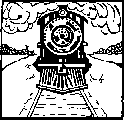

|
THE |
|
Contents |
|
Back-tracking Through History Pat Irving |
|
The US Standard railroad gauge (distance between the rails) is four feet, eight and a half Inches. That's an exceedingly odd number. Why was that gauge used? Because that's the way they built them In England, and the railroads were built by English expatriates. |
|
Why did the English people build them like that? Because the first rail lines were built by the same people who built the pre-railroad tramways, and that's the gauge they used. |
|
Why did 'they' use that gauge then? Because the people who built the tramways used the same jigs and tools that they used for building wagons, which used that wheel spacing. |
|
Okay! Why did the wagons use that odd wheel spacing? |
|
Well, if they tried to use any other spacing the wagons would break on some of the old, long distance roads, because that's the spacing of the old wheel ruts. |
|
So, who built these old rutted roads? |
|
The first long distance roads in Europe were built by Imperial Rome for the benefit of the legions. The roads have been used ever since. |
|
And the ruts? |
|
The Initial ruts, which everyone had to match for fear of destroying their wagons, were first made by war chariots. Since the chariots were made for or by Imperial Rome, they were all alike in the matter of wheel spacing. Thus, we have the answer to the original questions. |
|
The United States Standard railroad gauge of four feet, eight and a half Inches derives from the original specification for an Imperial Roman army war chariot. Specs and bureaucracies live forever. So, the next time you are handed a specification and wonder what horse's ass came up with it, you may be exactly right. Because the Imperial Roman chariots were made to be just wide enough to accommodate the back-ends of two war horses! |

